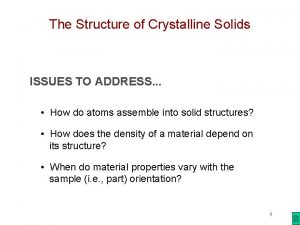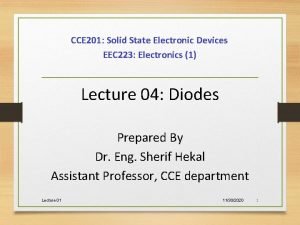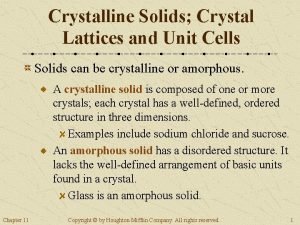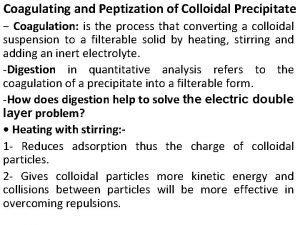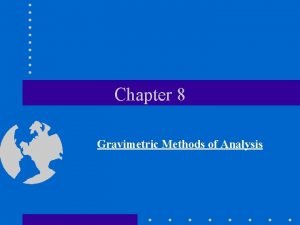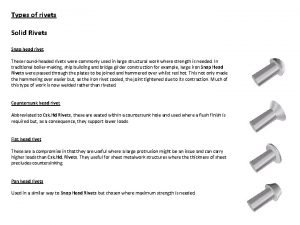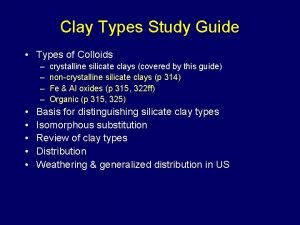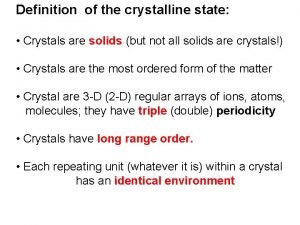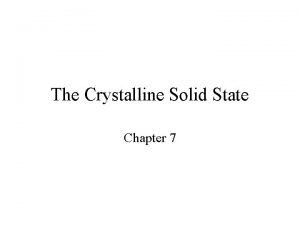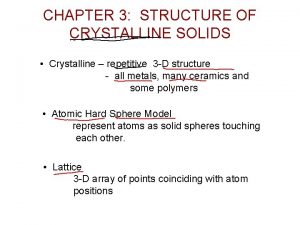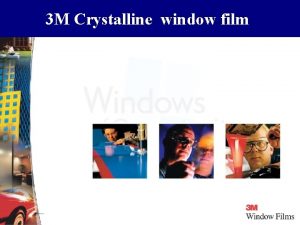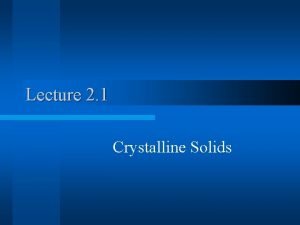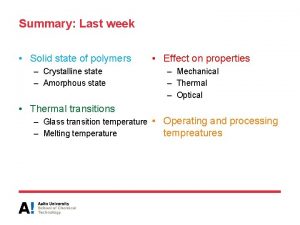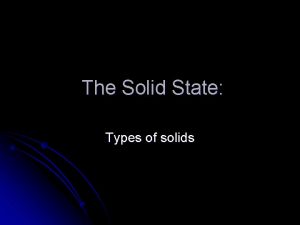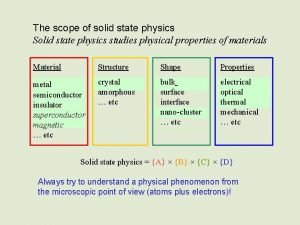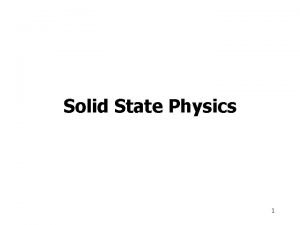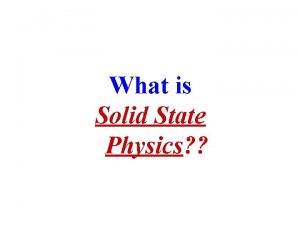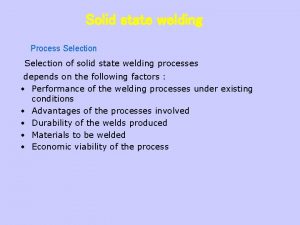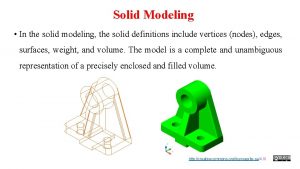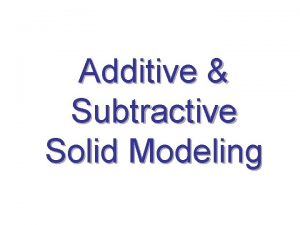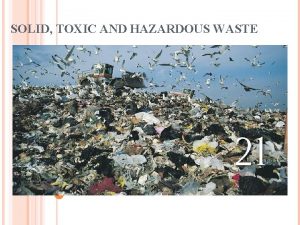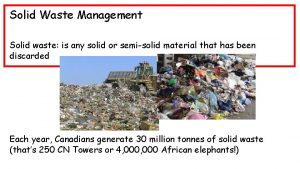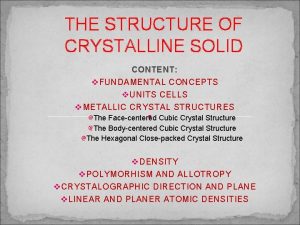The Crystalline Solid State Chapter 7 Crystalline Solid


























































- Slides: 58

The Crystalline Solid State Chapter 7

Crystalline Solid State • Many more “molecules” in the solid state. – We will focus on crystalline solids composed of atoms or ions. • Unit cell – structural component that, when repeated in all directions, results in a macroscopic (observable) crystal. – 14 possible crystal structures (Bravais lattices) – Discuss positions of atoms in the unit cell.

The Cubic Unit Cell (or Primitive) • 1 atom per unit cell (how? ). • What is the coordination number? Volume occupied? • Let’s calculate the length of the edge. What size of sphere would fit into the hole?

The Body-Centered Cubic • How many atoms per unit cell? • What is the length of the edge? This is a more complicated systems than the simple cubic.

Close-Packed Structures • How many atoms is each atom surrounded by in the same plane? • What is the coordination number? • Hexagonal close packing (hcp) – discuss the third layer (ABA). • Cubic close packing (ccp) or face-centered cubic (fcc) – discuss the third layer (ABC). • Two tetrahedral holes and one octahedral hole per atom. Can you see them?

Close-Packed Structures • The hcp has hexagonal prisms sharing vertical faces (Figure). – How many atoms per unit cell in the hcp structure? – What is the length of the cell edge? • The unit cell for the ccp or fcc is harder to see. – Need four close-packed layers to complete the cube. – What is the length of the cell edge? • In both close-packed structures, 74. 1% of the total volume is occupied.

Ionic Crystals • The tetrahedral and octahedral holes can have varying occupancies. • Holes are generally filled by smaller ions. – Tetrahedral holes – Octahedral holes • Na. Cl structure

Metallic Crystals • Most crystalize in bcc, ccp, and hcp structures. • Hard sphere model does not work well. – Depends on electronic structure. • Properties – Conductivity – Dislocations

Diamond • Each carbon atom is bonded tetrahedrally to four nearest neighbors (Figure). – Essentially the same strength in all directions.

Structures of Binary Compounds • Close-packed structures are generally defined by the larger ions (usually anions). The oppositelycharged ions occupy the holes. • Two important factors in considering the structure – Radius ratio (r+/r-) – Relative number of combining cations and anions.

Na. Cl Crystal Structure • Face-centered cubes of both ions offset by a half a unit cell in one direction. • Many alkali metals have this same geometry. • What is the coordination number (nearest neighbor)?

Cs. Cl Crystal Structure • Chloride ions form simple cubes with cesium ions in the center (Figure 7 -7). • The cesium ion is able to fit in to center hole. How? • Other crystal structures.

Ti. O 2 (the rutile structure) • Distorted Ti. O 6 octahedra. – Ti has a C. N. of 6, octahedral coordination – O has a C. N. of 3

Rationalization of Structure of Crystalline Solids • Predicting coordination number from radius ratio (r+/r-). – A hard sphere treatment of the ions. – Treats bonding as purely ionic. – Simply, as as the M+ ratio increases, more anions can pack around it. • Table 7 -1. Let’s look at a few (Na. Cl, Ca. F 2, and Ca. Cl 2).

Thermodynamics of Ionic Crystal Formation • A compound tends to adopt the crystal structure corresponding to lowest Gibbs energy. M+(g) + X-(g) MX(s) G = H - T S (standard state), 2 nd term can be ignored • Lattice enthalpy MX(s) M+(g) + X-(g) HL (standard molar enthalpy change) Currently, we are interested in lattice formation.

The Born-Haber Cycle • A special thermodynamic cycle that includes lattice formation as one step. • The cycle has to sum up to zero if written appropriately. • Write down values for KCl.

The Born-Haber Cycle • Calculate the lattice enthalpy for Mg. Br 2. • A discrepancy between this value and the real value may indicate the degree of covalent character. – We have assumed Coulombic interactions between ions. – The actual values for KCl and Mg. Br 2 are 701 and 2406 k. J/mol (versus 720 and 2451).

Lattice Enthalpy Calculations • Considering only Coulombic contributions – The electrostatic potential energy between each pair. z. A, z. B = ionic charges in electron units r 0 = distance between ion centers e = electronic charge 4 o = permittivity of a vacuum e 2/ 4 o = 2. 307 10 -28 J m Calculation would be performed on each cation/anion pair (nearest neighbor).

Lattice Enthalpy Calculations • A more accurate equation depicts the Coulombic interactions over the entire crystal. NA = Avogadro’s constant A = Madelung’s constant, value specific to a crystal type (in table). This is a sum of all the geometric factors carried out until the interaction become infinitesimal.

Lattice Enthalpy Calculations • Repulsions between ions in close proximity term. C’ = constant (will cancel out when finding the minimum) r = compressibility constant, ~ 30 pm • Combining terms

Lattice Enthalpy Calculations • Finding the minimum energy – d. U/dr 0 = O • A negative of this value may be defined as the lattice enthalpy.

Lattice Enthalpy Calculations • As the polarizability of the resultant ions increase the agreement with this ionic model worsens. – Polarizibility generally indicates more covalent character. Calculations Na. Cl and Ca. Br 2

Molecular Orbitals in Solids • A very large number of atoms are used to generate molecular orbitals. – One-dimensional model. – Creation of bands that are closely spaced. – Factors affecting the width of the band. This would be called an ‘s band’. A similar model can be constructed for the p-orbitals and d-orbitals.

The Bonding Picture in Solids

Molecular Orbitals in Solids • Band gap – separation between bands in which no MOs exist (Figure 7 -13). • Valence band – highest energy band containing electrons. • Conduction band – the band immediately above the valence band in energy.

Metals and Insulators • Metals – Partially filled valence band (e. g. s band) • Electrons move to slightly higher energy levels by applying a small voltage. Electrons and ‘holes’ are both free to move in the metal. – Overlapping bands (e. g. s and p bands) • If the bands are close enough in energy (or overlapping) an applied voltage can cause the electrons to jump into the next band (conduction band).

Density of States • Concentration of energy levels within a band. • Helps to describe bonding/reactivity in solids.

Conductivity of Solids Versus Temperature • Metals – decrease with temperature. • Semiconductors – increase with temperature. • Insulators – increase with temperature (if measurable).

Semiconductor Types • Intrinsic semiconductors – pure material having semiconductive properties. • Doped semiconductors – semiconductors that are fabricated by adding a small amount of another element with energy levels close to the pure state material. – n-type semiconductors – p-type semiconductors (look at figure)

Semiconductors • Fermi-level (semiconductor) – the energy at which an electron is equally likely to be in each of two levels (Figure). • Effects of dopants on the Fermi level. – n-type and p-type.

Diodes (creating p-n junctions) • Migration of electrons from the n-type material to the p-type material. – Equilibrium is established due to charge transfer. • Application of a negative potential to the ntype material and a positive potential to the ptype material. – Discuss (Figure 7 -16).

Superconductivity • No resistance to flow of electrons. – Currents started in a loop will continue to flow indefinitely. • Type I superconductors – expel all magnetic fields below a critical temperature, Tc (Meisner effect). • Type II superconductors – below a critical temperature exclude all magnetic fields completely. Between this temperature and a second critical temperature, they allow partial penetration by the magnetic field. – Levitation experiment works well.

Theory of Superconducting • Cooper pair theory – Bardeen, Cooper, and Schrieffer – Electrons travel through the material in pairs. – The formation and propagation of these pairs is assisted by small vibrations in the lattice. • discuss

YBa 2 Cu 3 O 7 High-Temperature Superconductors • Discovered in 1987 and has a Tc of 93 K. – N 2(l) can be used • Type II superconductor. • Difficult to work with. • Possesses copper oxide planes and chains.

Bonding in Solid State Structures • The hard-sphere model is too simplistic. – Deviations are observed in ion sizes. – Sharing of electrons (or transfer back to the cation) can vary depending upon the polarizability. • Li. I versus Na. Cl (which structure would exhibit more covalent character? )

Bonding in Ti. O 2 • The crystal has a rutile structure. – Each titanium has ___ nearest neighbors and each oxygen atom has ___ nearest neighbors. • There is no effective O···O or Ti···Ti interactions (only Ti···O interactions). Why? • The structure consists of Ti. O 6 fragments (discuss).

Bonding in Ti. O 2 For a Ti. O 6 monomer (no significant -bonding). An approximation of the ‘bands in the solid structure.

Bonding in Ti. O 2 • The calculated DOS curve in 3 -d space is slightly more complicated. • The O 2 s, O 2 p, Ti t 2 g, and eg bands are well separate. The separation predicts that this material has ‘insulator-like’ properties.

Bonding in Ti. O • Several of the 3 d monoxides illustrate high conductivity that decreases with temperature. – Ti. O and VO (positioning in the table). • Ti. O adopts the rocksalt structure (Na. Cl). – Discuss geometry and consequences on bonding.

Bonding in Ti. O • The titanium atoms are close enough to form a ‘conduction’ band. – Overlap of t 2 g orbitals of the metal ions in neighboring octahedral sites. – Illustrated for dxy orbitals.

Bonding in Ti. O • The calculated DOS curve for Ti. O reveals that the bonds aren’t well separated. – Diffuse bands indicate more conductive behavior. • Why is Ti. O 2 different than Ti. O?

Bonding in Ti. O • Mn. O, Fe. O, Co. O, and Ni. O do not conduct, but they have the same basic structure. Why?

Imperfections in Solids • All crystalline solids possess imperfections. – Crystal growth occurring at many sites causes boundaries to form. – Vacancies and self-interstitials – Substitutions – Dislocations

Silicates • The earth’s crustal rocks (clays, soils, and sands) are composed almost entirely (~95%) of silicate minerals and silica (O, Si, and Al). – There exist many structural types with widely varying stoichiometries (replacement of Si by Al is common). Consequences? • Common to all: – Si. O 4 tetrahedra units • Si is coordinated tetrahedrally to 4 oxygens http: //www. soils. wisc. edu/virtual_museum/displays. html http: //mineral. galleries. com/minerals/silicate/class. htm

The Tetrahedral Si. O 4 Unit Cheetham and Day

Structures with the Si. O 4 Unit • Discrete structural units which commonly contain cations for charge balance. • Corner sharing of O atoms into larger units. – O lattice is usually close-packed (near) – Charge balance is obtained by presence of cations. Individual units, chains, multiple chains (ribbons), rings, sheets and 3 -d networks.

Structure Containing Discrete Units • Nesosilicates – no O atoms are shared. – Contain individual Si. O 44 - units. – Zr. Si. O 4 (zircon) – illustrate with softwares • Stoichiometry dictates 8 -fold coordination of the cation. – (Mg 3 or Fe 3)Al 2 Si 3 O 12 (garnet) – illustrate with softwares • 8 -fold coordination for Mg or Fe and 6 -fold coordination for the Al.

Structure Containing Discrete Units • The sorosilicates (disilicates) – 1 O atom is shared. – Contain Si 2 O 76 - units – Show Epidote (Ca 2 Fe. Al 2(Si. O 4)(Si 2 O 7)O(OH)) with softwares. • Epidote contains Si. O 44 - and Si 2 O 76 - units – Near linear Si-O-Si bond angle between tetrahedra.

Cyclosilicates (discrete cyclic units) • Each Si. O 4 units shares two O atoms with neighboring Si. O 4 tetrahedra. – Formula – Si. O 32 - or [(Si. O 3)n]2 n- (n=3 -6 are the most common. – Beryl – six-linked Si. O 4 tetrahedra (show with softwares). • Be 3 Al 2(Si. O 3)6 – contains Si 6 O 1812 - cyclic units • The impurities produce its colors. – Wadeite – three-linked Si. O 4 tetrahedra (don’t have an actual picture) • K 2 Zr. Si 3 O 9

Silicates with Chain or Ribbon Structures • Corner sharing of Si. O 4 tetrahedra (Si. O 32 -) – Very common (usually to build up more complicated silicate structures). • Differing conformations can be adopted by linked tetrahedra. – Changes the repeat distance. – The 2 T structure is the most common (long).

Silicates with Chain or Ribbon Structures • The chains are usually packed parallel to provide sites of 6 and 8 coordination for the cations. – Jadeite [Na. Al. Si 2 O 6] • Illustrate the different repeat units. • What is the repeat unit?

Silicate Chains Linking Together • Can form double or triple chains/ribbons linked together (or more). • Depends on the repeat unit in the chain. • Tremolite [Ca 2 Mg 5(Si 4 O 11)2(OH)2 (illustrate with softwares) Asbestos mineral (fibrous) • Triple chain

Phyllosilicates (Silicates with Layer Structures) • Clay minerals, micas, talc, soapstone. • Individual layers are formed by sharing 3 of the 4 atoms of each tetrahedron. • Simplest structure is made up of a 2 T network of silicate chains to give a network composition of Si 2 O 52 -. – This is exhibited with kaolinite (illustrate the silicon tetrahedral layer).

Creation of Layers in the Phyllosilicates • Can be formed by sharing the fourth O atom between pairs of tetrahedra. – Produces an Si. O 2 stoichiometry (neutral) – Replacing Si with Al • Al 2 Si 2 O 82 -; requires charge balance. The cations connect the double layers.

Creation of Layers in the Phyllosilicates • Double layers can be produced by interleaving layers of the gibbsite Al(OH)3 or brucite Mg(OH)2 structure. – Incorporation of gibbsite produces kaolinite, [Al 2(OH)4 Si 2 O 5] (China clay); illustrate with software the different layers present. – Placing a Si. O layer on the other side of the Al. O layer produces pyrophyllite, [Al 2(OH)2 Si 4 O 10]. • Illustrate both with software.

More Layered Structures • The Al can be replaced by Mg (2: 3) ratio. – Kaolinite serpentine asbestos – Pyrophyllite talc • Charged layers can also result by replacing the framework Si with Al or other cations. For charge balance these layers can be interleaved with M(+1) or M(+2) to give micas (illite) or by layers of hydrated cations to give montmorillonite. – Illustrate both.

The Tectosilicates • Each oxygen atom is shared by 2 tetrahedra (Si. O 2 formula). • Silica ( -quartz; one crystalline form) – Si-O-Si bond angles are ~144 degrees. – Contains helical chains of Si. O 4. • Six combine to form hexagonal shape (illustrate).

The Tectosilicates (Zeolites aluminosilicates) • A large fraction of the Si atoms are replaced with Al (other metals can also be used). – Charge balance will be required (Si, Al)n. O 2 n. • Contain cavities that allow molecules to enter. – Able to tailor electronic and physical properties. • Pore structure and cation exchange. • Illustrate with software.
 Crystalline solid and amorphous solid
Crystalline solid and amorphous solid Packing fraction of bcc
Packing fraction of bcc Honors its atomic
Honors its atomic Crystalline solid and amorphous solid
Crystalline solid and amorphous solid Crystalline solid and amorphous solid
Crystalline solid and amorphous solid Solid state physics
Solid state physics Crystal solid and amorphous solid
Crystal solid and amorphous solid Crystalline solid
Crystalline solid Crystalline solid
Crystalline solid Solid state electronic devices 7th solution chapter 4
Solid state electronic devices 7th solution chapter 4 Crystalline substances
Crystalline substances Crystalline candy
Crystalline candy Difference between colloidal and crystalline precipitate
Difference between colloidal and crystalline precipitate Difference between occlusion and mixed-crystal formation
Difference between occlusion and mixed-crystal formation Difference between colloidal and crystalline precipitate
Difference between colloidal and crystalline precipitate Inorganic precipitating agents examples
Inorganic precipitating agents examples Type of
Type of Crystalline silicate clays
Crystalline silicate clays Definition of crystalline
Definition of crystalline Destiny 2 crystalline formations
Destiny 2 crystalline formations Solid in solid solution
Solid in solid solution Covalent network solid vs molecular solid
Covalent network solid vs molecular solid When a solid completely penetrates another solid
When a solid completely penetrates another solid When a solid completely penetrates another solid
When a solid completely penetrates another solid Evaporation example mixture
Evaporation example mixture Hát kết hợp bộ gõ cơ thể
Hát kết hợp bộ gõ cơ thể Ng-html
Ng-html Bổ thể
Bổ thể Tỉ lệ cơ thể trẻ em
Tỉ lệ cơ thể trẻ em Voi kéo gỗ như thế nào
Voi kéo gỗ như thế nào Tư thế worm breton
Tư thế worm breton Chúa sống lại
Chúa sống lại Các môn thể thao bắt đầu bằng tiếng đua
Các môn thể thao bắt đầu bằng tiếng đua Thế nào là hệ số cao nhất
Thế nào là hệ số cao nhất Các châu lục và đại dương trên thế giới
Các châu lục và đại dương trên thế giới Cong thức tính động năng
Cong thức tính động năng Trời xanh đây là của chúng ta thể thơ
Trời xanh đây là của chúng ta thể thơ Cách giải mật thư tọa độ
Cách giải mật thư tọa độ Làm thế nào để 102-1=99
Làm thế nào để 102-1=99 Phản ứng thế ankan
Phản ứng thế ankan Các châu lục và đại dương trên thế giới
Các châu lục và đại dương trên thế giới Thơ thất ngôn tứ tuyệt đường luật
Thơ thất ngôn tứ tuyệt đường luật Quá trình desamine hóa có thể tạo ra
Quá trình desamine hóa có thể tạo ra Một số thể thơ truyền thống
Một số thể thơ truyền thống Bàn tay mà dây bẩn
Bàn tay mà dây bẩn Vẽ hình chiếu vuông góc của vật thể sau
Vẽ hình chiếu vuông góc của vật thể sau Nguyên nhân của sự mỏi cơ sinh 8
Nguyên nhân của sự mỏi cơ sinh 8 đặc điểm cơ thể của người tối cổ
đặc điểm cơ thể của người tối cổ Thứ tự các dấu thăng giáng ở hóa biểu
Thứ tự các dấu thăng giáng ở hóa biểu Vẽ hình chiếu đứng bằng cạnh của vật thể
Vẽ hình chiếu đứng bằng cạnh của vật thể Fecboak
Fecboak Thẻ vin
Thẻ vin đại từ thay thế
đại từ thay thế điện thế nghỉ
điện thế nghỉ Tư thế ngồi viết
Tư thế ngồi viết Diễn thế sinh thái là
Diễn thế sinh thái là Dot
Dot Số.nguyên tố
Số.nguyên tố Tư thế ngồi viết
Tư thế ngồi viết

